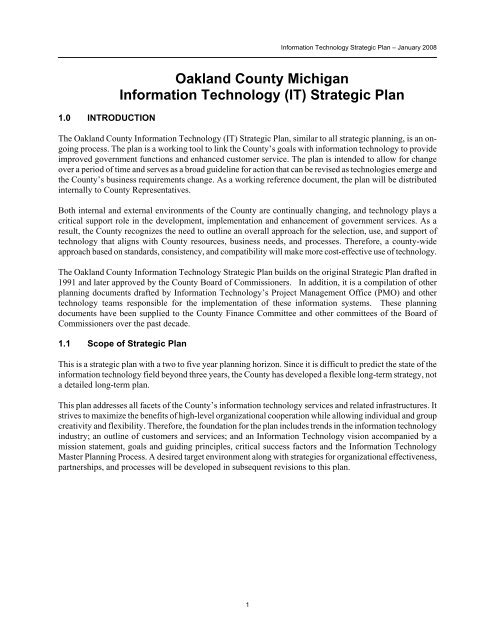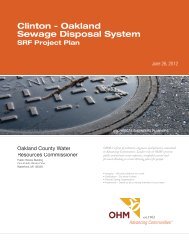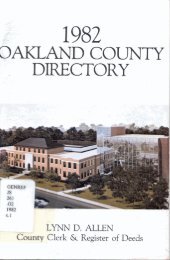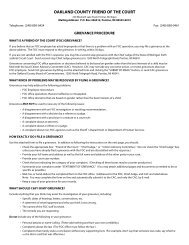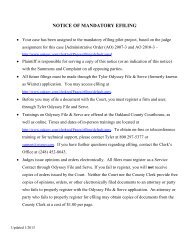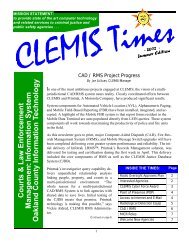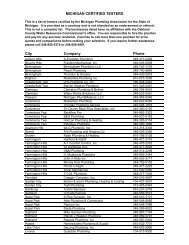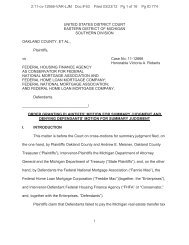Oakland County Michigan Information Technology (IT) Strategic Plan
Oakland County Michigan Information Technology (IT) Strategic Plan
Oakland County Michigan Information Technology (IT) Strategic Plan
Create successful ePaper yourself
Turn your PDF publications into a flip-book with our unique Google optimized e-Paper software.
<strong>Information</strong> <strong>Technology</strong> <strong>Strategic</strong> <strong>Plan</strong> – January 2008<br />
1.0 INTRODUCTION<br />
<strong>Oakland</strong> <strong>County</strong> <strong>Michigan</strong><br />
<strong>Information</strong> <strong>Technology</strong> (<strong>IT</strong>) <strong>Strategic</strong> <strong>Plan</strong><br />
The <strong>Oakland</strong> <strong>County</strong> <strong>Information</strong> <strong>Technology</strong> (<strong>IT</strong>) <strong>Strategic</strong> <strong>Plan</strong>, similar to all strategic planning, is an ongoing<br />
process. The plan is a working tool to link the <strong>County</strong>’s goals with information technology to provide<br />
improved government functions and enhanced customer service. The plan is intended to allow for change<br />
over a period of time and serves as a broad guideline for action that can be revised as technologies emerge and<br />
the <strong>County</strong>’s business requirements change. As a working reference document, the plan will be distributed<br />
internally to <strong>County</strong> Representatives.<br />
Both internal and external environments of the <strong>County</strong> are continually changing, and technology plays a<br />
critical support role in the development, implementation and enhancement of government services. As a<br />
result, the <strong>County</strong> recognizes the need to outline an overall approach for the selection, use, and support of<br />
technology that aligns with <strong>County</strong> resources, business needs, and processes. Therefore, a county-wide<br />
approach based on standards, consistency, and compatibility will make more cost-effective use of technology.<br />
The <strong>Oakland</strong> <strong>County</strong> <strong>Information</strong> <strong>Technology</strong> <strong>Strategic</strong> <strong>Plan</strong> builds on the original <strong>Strategic</strong> <strong>Plan</strong> drafted in<br />
1991 and later approved by the <strong>County</strong> Board of Commissioners. In addition, it is a compilation of other<br />
planning documents drafted by <strong>Information</strong> <strong>Technology</strong>’s Project Management Office (PMO) and other<br />
technology teams responsible for the implementation of these information systems. These planning<br />
documents have been supplied to the <strong>County</strong> Finance Committee and other committees of the Board of<br />
Commissioners over the past decade.<br />
1.1 Scope of <strong>Strategic</strong> <strong>Plan</strong><br />
This is a strategic plan with a two to five year planning horizon. Since it is difficult to predict the state of the<br />
information technology field beyond three years, the <strong>County</strong> has developed a flexible long-term strategy, not<br />
a detailed long-term plan.<br />
This plan addresses all facets of the <strong>County</strong>’s information technology services and related infrastructures. It<br />
strives to maximize the benefits of high-level organizational cooperation while allowing individual and group<br />
creativity and flexibility. Therefore, the foundation for the plan includes trends in the information technology<br />
industry; an outline of customers and services; and an <strong>Information</strong> <strong>Technology</strong> vision accompanied by a<br />
mission statement, goals and guiding principles, critical success factors and the <strong>Information</strong> <strong>Technology</strong><br />
Master <strong>Plan</strong>ning Process. A desired target environment along with strategies for organizational effectiveness,<br />
partnerships, and processes will be developed in subsequent revisions to this plan.<br />
1
<strong>Information</strong> <strong>Technology</strong> <strong>Strategic</strong> <strong>Plan</strong> – January 2008<br />
1.2 <strong>Oakland</strong> <strong>County</strong> Overview<br />
<strong>Oakland</strong> <strong>County</strong> <strong>Michigan</strong> covers 910 square miles, has 61 cities, villages, and townships (CVTs) and is<br />
located in southeast <strong>Michigan</strong>, immediately north of the City of Detroit. Located astride the Interstate 75<br />
corridor and at the heart of “Automation Alley”, <strong>Oakland</strong> <strong>County</strong> is a world class technology center. In 2000,<br />
<strong>Oakland</strong> <strong>County</strong>’s population was 1,194,156, a 10.2% increase from 1990. With approximately 440,000<br />
parcels of property and an increase of approximately 7,000 parcels per year, <strong>Oakland</strong> <strong>County</strong> has added over<br />
10 billion dollars in total property value over each of the last five years. <strong>Oakland</strong> <strong>County</strong> features among the<br />
lowest operating tax rates in the state, has perennially been the highest job-producing county in <strong>Michigan</strong>, and<br />
is home to six Fortune 500 companies. <strong>Oakland</strong> <strong>County</strong> is one of two dozen counties in the nation with the<br />
coveted AAA bond rating and in 1998, a bond rating agency ranked <strong>Oakland</strong> <strong>County</strong> the best run county in<br />
America.<br />
Over the next several years, many CVTs may find themselves struggling with securing qualified information<br />
technology resources at a price they can afford. Changing technologies, integration of suite products and<br />
software complexities will continue to concern the local municipalities in their efforts to cope. The situation<br />
is expected to get much worse over the next several years.<br />
The expense of highly qualified technology personnel and the limitations on property tax revenue will inhibit<br />
technology initiatives absent some <strong>County</strong> involvement. The constitutional cap placed on taxable value<br />
growth combined with the annual millage rollbacks has restricted discretionary spending for many local<br />
CVTs. This trend will continue into the foreseeable future. Yet, there is hope as the <strong>County</strong> has recognized<br />
these issues faced by the CVTs and is taking active steps to assist in its resolution.<br />
Over the last several years, <strong>Oakland</strong> <strong>County</strong> has been aggressively replacing existing mainframe programs<br />
with improved vendor-supported systems. As the <strong>IT</strong> Department has addressed these systems for <strong>County</strong><br />
departments, the CVTs have been kept in mind as well. The benefits derived from the investments can be<br />
obtained from other sets of governmental units, namely the local municipalities.<br />
Unlike many counties in <strong>Michigan</strong>, or in the nation, <strong>Oakland</strong> <strong>County</strong> and its local municipalities cooperate in<br />
the performance of services to residents. Traditionally, counties and CVTs work independent of one another -<br />
not in <strong>Oakland</strong> <strong>County</strong>. The <strong>County</strong> on behalf of the local municipalities performs many services (much of<br />
which is in the technology arena) normally rendered by BOTH entities in other counties. The <strong>County</strong> often<br />
incurs the financially responsibility itself with incremental costs that provide direct technology programs and<br />
economic benefits to CVTs. In many instances, the funding of computer programs by the <strong>County</strong> would<br />
enable operating programs that could not otherwise be performed by smaller CVTs. This “centralized<br />
computing” practice is unique compared to many counties, where each of the local municipalities, and even<br />
<strong>County</strong> departments, has their own computer systems that do not integrate with each other.<br />
The benefits of providing these services centrally, rather than separately (CVT and the <strong>County</strong> as well),<br />
results in an overall cost reduction for services to the taxpayers in <strong>Oakland</strong> <strong>County</strong>. Essentially fixed costs of<br />
computer services are spread over a larger economic base - thus, reducing the cost per unit served.<br />
2
<strong>Information</strong> <strong>Technology</strong> <strong>Strategic</strong> <strong>Plan</strong> – January 2008<br />
1.3 <strong>Information</strong> <strong>Technology</strong> Department Overview<br />
The Department of <strong>Information</strong> <strong>Technology</strong> is a service bureau that provides <strong>IT</strong> services to 82 <strong>County</strong><br />
Divisions, more than 100 local governmental units (assessors, treasurers, law enforcement, etc.), over 50<br />
private sector customers, and over 1,300 @ccess <strong>Oakland</strong> customers. <strong>IT</strong> is responsible for over 150 major<br />
applications consisting of more than 8,000 programs and provides systems support, maintenance,<br />
enhancements and new development for all major systems applications.<br />
The Department of <strong>Information</strong> <strong>Technology</strong> is under the administration of the <strong>County</strong> Executive and is<br />
comprised of the following five organizational divisions:<br />
• Administration – Internal Services • Application Services<br />
• CLEMIS • Technical Systems and Networking<br />
The <strong>IT</strong> Department has 164 employees and approximately 40-50 contract professional services staff.<br />
There are approximately 52 unique job classifications within the <strong>IT</strong> Department.<br />
Administration – Internal Services Division<br />
The Administration – Internal Services Division is comprised of the following Operational Units: Project<br />
Management Office (PMO), Service Center, Training & Communications, and Administrative Services.<br />
This division supports <strong>Information</strong> <strong>Technology</strong> and the <strong>County</strong> in functions related to Project Management,<br />
Training and Customer Support. This includes the following:<br />
• <strong>IT</strong> Annual Master <strong>Plan</strong>ning and Leadership Group Processes<br />
• Project Management support and assistance to <strong>IT</strong> Project Managers<br />
• Hands-on instruction and training, customized to the needs of <strong>County</strong> and CVT employees to<br />
empower them with skills in standard software products, providing the skills necessary to<br />
complete their tasks effectively and efficiently<br />
• Service Center Customer Support Services<br />
• <strong>IT</strong> Employee Training and Education<br />
• <strong>IT</strong> Department Communication Processes<br />
• <strong>IT</strong> Service Center - Telephone Communications<br />
• <strong>IT</strong> Purchasing, Accounts Payable, Billing and Clerical staff functions<br />
• <strong>IT</strong> Department Policies and Procedures and Human Resource Administration<br />
3
<strong>Information</strong> <strong>Technology</strong> <strong>Strategic</strong> <strong>Plan</strong> – January 2008<br />
CLEMIS Division<br />
The CLEMIS (Courts and Law Enforcement Management <strong>Information</strong> System) and Public Safety program<br />
provides computer technology, radio communications, and related services to criminal justice and public<br />
safety agencies (police, fire, and emergency medical services). CLEMIS, a regional law enforcement<br />
consortium, provides solutions through a cooperative effort that are affordable and efficient for agencies of all<br />
sizes. Over 200 police, fire and emergency medical services agencies in a six county region rely on CLEMIS<br />
for up to 20 different Public Safety software and hardware solution needs. By serving as a technical link<br />
among multiple agencies, the program promotes communication and sharing of criminal justice information.<br />
CLEMIS also facilitates the maintenance of fire and emergency medical records. The program's standards are<br />
monitored by the CLEMIS Advisory Committee, and nine sub-committees to ensure the integrity of<br />
information entered into the system. The CLEMIS program empowers criminal justice and public safety<br />
agencies to maximize the use of collected data, for their daily operations and comprehensive planning. This<br />
division is also responsible for the <strong>County</strong>'s E911 equipment and its integration with the Computer Aided<br />
Dispatch system. CLEMIS staff provides all the necessary training to the agencies as well as 24 X 7 support.<br />
The CLEMIS Division is comprised of four teams: Public Safety Applications, Corrections-Biometric<br />
Applications, Tech/Field Services, and Radio Communications.<br />
Application Services Division<br />
The Application Services Division is comprised of the following Operational Units: Land Management<br />
Technologies, Courts, Finance and Human Resources Systems and eGovernment. The program is responsible<br />
for development of new applications, enhancements to existing applications, and support and maintenance of<br />
both <strong>Oakland</strong> <strong>County</strong> developed software and purchased software.<br />
The Land Management Technologies program is responsible for information systems used in land-related<br />
business functions. These business functions include: assessment, taxation, planning and economic<br />
development, homeland security, infrastructure management, and well/septic inspections. Geographic<br />
<strong>Information</strong> Systems (GIS) is the primary technology used to support these diverse departments and local<br />
CVTs.<br />
The Courts program provides <strong>IT</strong> development to <strong>Oakland</strong> <strong>County</strong>'s Circuit Court, Probate Court, the 52 nd<br />
District Courts, Prosecuting Attorney, Clerk/Register of Deeds, Community Corrections, Board of<br />
Commissioners, Medical Examiner’s Office, Circuit Court Probation, and the non-CLEMIS functions of the<br />
Sheriff's Office.<br />
The Financial/Administrative program provides <strong>IT</strong> development and support to <strong>Oakland</strong> <strong>County</strong>'s <strong>County</strong><br />
Executive, Treasurer, Management and Budget, Human Resources, Facilities Management, Central Services<br />
and <strong>Information</strong> <strong>Technology</strong> departments.<br />
The eGovernment program supports the <strong>County</strong>’s entire Internet presence. In fiscal year 2008, 3.1 million<br />
web site visitors viewed 20.1 million pages of content and downloaded 773,637 PDF files from the <strong>County</strong><br />
web site. The <strong>County</strong>’s web site contains 20,396 Internet and 5,076 Intranet pages and averaged 265,314<br />
visitor sessions per month with over 20 million pages viewed per year. In addition, the program provides web<br />
site content management activities including overall editing, proofreading, standards compliance, graphics,<br />
photos, sound and video.<br />
4
<strong>Information</strong> <strong>Technology</strong> <strong>Strategic</strong> <strong>Plan</strong> – January 2008<br />
Technical Systems and Networking Division<br />
The Technical Systems and Networking Division are comprised of the following Operational Units: Data<br />
Base Administration, Server Administration, Network Services, Technical Operations, Workstation Services,<br />
and Telephone Communications.<br />
The Technical Systems and Networking program manages the <strong>County</strong>-wide network, communications, and<br />
computing infrastructure 24 hours a day including:<br />
• Monitoring, security, configuration, and troubleshooting activities<br />
• Maintaining and extending a fiber optic network connecting the <strong>County</strong> and the CVTs to better<br />
coordinate data, video, and voice communications<br />
• Managing file, print, application, and mail servers, including security administration, operating<br />
system upgrade and maintenance, capacity planning, anti-virus scanning, and monitoring<br />
• Establishing standard development platforms and methodologies encompassing such areas as<br />
mainframe and PC application development, database creation, design, and naming, application<br />
product selection, and standard software suites and applications<br />
• Developing procedures and plans to facilitate disaster recovery, data protection, and data recovery<br />
• Workstation, workstation software, and workstation peripheral configuration, maintenance, delivery<br />
and problem resolution<br />
• Traditional telephone services, pager services, pay phones and cellular phone services, having its own<br />
Private Branch Exchange (PBX) system telephone switch allowing for reduced costs for operations,<br />
including toll charges.<br />
5
<strong>Information</strong> <strong>Technology</strong> <strong>Strategic</strong> <strong>Plan</strong> – January 2008<br />
Overall, <strong>Information</strong> <strong>Technology</strong>’s customer base spans several different disciplines, including:<br />
• Health and Human Services • Equalization and Treasurer<br />
• Court Services • Finance and Human Resources<br />
• Public Safety (Police, Fire, EMS) • Water Resources Commissioner<br />
• Clerk/Register of Deeds • MSU Extension/<strong>Oakland</strong> <strong>County</strong><br />
• Community & Economic Development • Parks & Recreation<br />
• Sheriff • Prosecuting Attorney<br />
• <strong>County</strong> Executive • Board of Commissioners<br />
• <strong>Oakland</strong> <strong>County</strong> International Airport • Facilities Management<br />
• CVTs • External Customers<br />
<strong>Information</strong> <strong>Technology</strong> provides a number of services to its customers, in general, <strong>IT</strong> services provided<br />
include:<br />
<strong>Information</strong> (Data) Services<br />
RDBMS and Mainframe Database Administration<br />
and Standards<br />
RDBMS and Mainframe Database Design, Access<br />
and Security<br />
RDBMS and Mainframe Database Recovery and Data Warehouse Design, Access and Security<br />
Storage<br />
GIS Database Design, Access and Security Digital Picture Database Administration<br />
24/7 Data Center Management<br />
Application Development Services<br />
New Product Research and Testing<br />
Custom Application Development and Code<br />
Management<br />
“Commercial Off the Shelf” Software Selection and Business Process Improvement<br />
Implementation<br />
Office Automation Software<br />
“Commercial Off the Shelf” Software Maintenance<br />
and Support<br />
<strong>Technology</strong> Services<br />
Asset Management<br />
Automated Software Delivery<br />
Anti-Virus Maintenance and Control<br />
<strong>Technology</strong> Standards Management<br />
Internet Services (Web Hosting, FTP, and Web LAN Network Administration and Management<br />
Browsing)<br />
Network Directory Services and File Storage WAN Network Administration and Management<br />
Disaster Recovery <strong>Plan</strong>ning<br />
Printing, Plotting and Fax Management<br />
Telephone and Paging Management<br />
Remote Access Management<br />
Network Security and Authentication<br />
PC Support and Maintenance<br />
Video Conferencing Services<br />
Server Hardware Support and Maintenance<br />
Internet Security and Firewall Management <strong>Technology</strong> Testing and Prototyping<br />
Wireless Network Administration and Mgmt. Web Site Design<br />
Training and Support Services<br />
24/7 Service Center Support <strong>Technology</strong> Newsletters and Publications<br />
Software and Application Training<br />
<strong>Technology</strong> Project Management and Mentoring<br />
6
<strong>Information</strong> <strong>Technology</strong> <strong>Strategic</strong> <strong>Plan</strong> – January 2008<br />
2.0 Mission Statement<br />
To be a leader in providing government services through innovative, reliable, and responsive information<br />
technology solutions.<br />
2.1 Guiding Principles<br />
2.1.1 To provide the highest quality customer service in partnership with government agencies,<br />
citizens, communities, and customers<br />
2.1.2 To provide leadership through the strategic use of technology<br />
2.1.3 To ensure executive support and commitment from <strong>County</strong> Executive, Board of<br />
Commissioners, and other elected officials<br />
2.1.4 To ensure all <strong>County</strong> agencies will be treated as equal and important partners of the <strong>IT</strong><br />
Department<br />
2.1.5 To empower <strong>IT</strong> customers to become more self-sufficient and technologically confident<br />
2.1.6 To encourage county departments and local governments to use information technology to<br />
improve and deliver services<br />
2.1.7 To recruit and retain a technically competent workforce<br />
2.1.8 To develop, maintain, and distribute high-quality information in support of decision making<br />
and collaboration<br />
2.1.9 To embrace the application of new technology to improve business workflow<br />
2.1.10 To effectively communicate with the customer community<br />
2.1.11 To promote cross boundary collaboration<br />
3.0 Strategies and Initiatives<br />
The following <strong>Information</strong> <strong>Technology</strong> strategies represent broad statements of desired accomplishments:<br />
Each of these strategies is supported by projects within the <strong>IT</strong> Master <strong>Plan</strong>.<br />
3.1 Provide an Enhanced Application Service Offering<br />
3.1.1 Increase application integration through web services<br />
3.1.2 Research and develop a Constituent Relationship Management (CRM) strategy<br />
3.1.3 Promote mobility and location integration in business applications<br />
3.1.4 Utilize ecommerce platform to offset costs and expand product offerings to customers<br />
3.1.5 Improve the quality, reliability and availability of all applications<br />
3.1.6 Increase the agility and responsiveness of business units by expanding customer analytics<br />
3.1.7 Leverage the <strong>County</strong>’s Internet presence and portal as a branded consolidated point of access<br />
to all <strong>County</strong> information and services through a web browser<br />
3.1.8 Centralize identity and access management for all applications and content<br />
7
<strong>Information</strong> <strong>Technology</strong> <strong>Strategic</strong> <strong>Plan</strong> – January 2008<br />
3.2 Enhance ability to provide effective and timely customer (<strong>County</strong> departments and<br />
CVTs) service<br />
3.2.1 Implement a centralized service center strategy to provide a single point of contact for<br />
service delivery<br />
3.2.2 Implement the <strong>IT</strong> Infrastructure Library (<strong>IT</strong>IL) best practice framework for <strong>IT</strong> Service<br />
Management<br />
3.2.3 Define a service and support strategy that clearly identifies the <strong>IT</strong> services provided<br />
3.2.4 Provide a high-quality training program to empower employees through technology<br />
3.2.5 Develop a formalized customer communication plan<br />
3.2.6 Build <strong>IT</strong> Staff expertise through professional development<br />
3.2.7 Expand capacity through ongoing organizational review and selective outsourcing<br />
3.3 Implement a Standardized Infrastructure Strategy<br />
3.3.1 Deliver services using a shared technology infrastructure wherever possible<br />
3.3.2 Implement a Microsoft infrastructure strategy<br />
3.3.3 Implement a consolidated security management strategy<br />
3.3.4 Establish a standard personal computing hardware and software product suite, SLA, and<br />
replacement schedule for all <strong>County</strong> personal computers<br />
3.3.5 Establish support cost model and SLA for all offerings outside 3.3.4<br />
3.3.6 Improve service availability through network design and management strategies<br />
3.3.7 Establish enhanced capacity planning and recovery management strategies<br />
4.0 MEASUREMENT<br />
Measurement of the <strong>IT</strong> <strong>Strategic</strong> <strong>Plan</strong> is detailed in the <strong>IT</strong> Master <strong>Plan</strong> and Quarterly Status Reports. These<br />
reports contain a measurement of each program and project in the <strong>IT</strong> Department. In addition, Project<br />
Sponsors submitting <strong>IT</strong> project requests are required to complete the Return on Investment (ROI) Analysis.<br />
The ROI Analysis quantifies the anticipated benefits to <strong>Oakland</strong> <strong>County</strong> resulting from successful completion<br />
of the proposed project. The ROI Analysis documents development and operational costs as well as<br />
anticipated, quantifiable benefits resulting from the proposed project. The ROI Analysis is a living, breathing<br />
document that is updated and resubmitted throughout the life of the project. Master <strong>Plan</strong> and project status is<br />
continually provided to customers and the Board of Commissioners.<br />
5.0 SUMMARY<br />
With the internal and external business climates of the <strong>County</strong> in a state of continuous evolution, technology<br />
and information systems will continue to play a critical role in the delivery of efficient government services.<br />
The <strong>Oakland</strong> <strong>County</strong> <strong>IT</strong> <strong>Strategic</strong> <strong>Plan</strong> is a living document and supporting process that provides a flexible,<br />
compatible, and integrated technology and information system strategy.<br />
The <strong>IT</strong> <strong>Strategic</strong> <strong>Plan</strong> builds on prior <strong>IT</strong> <strong>Strategic</strong> <strong>Plan</strong>s drafted by the <strong>IT</strong> Steering Committee. In addition, it<br />
is a compilation of other planning documents prepared by <strong>Information</strong> <strong>Technology</strong>’s PMO and other<br />
technology teams responsible for the implementation of these information systems. The foundation for the<br />
plan includes trends in the information technology industry; an outline of customers and services; and an<br />
8
<strong>Information</strong> <strong>Technology</strong> <strong>Strategic</strong> <strong>Plan</strong> – January 2008<br />
<strong>Information</strong> <strong>Technology</strong> vision, accompanied by a mission statement, goals and guiding principles, critical<br />
success factors and the <strong>Information</strong> <strong>Technology</strong> Master <strong>Plan</strong>ning Process. In the future, this foundational plan<br />
will be used to develop subsequent revisions that include a desired target environment along with strategies<br />
for organizational effectiveness, partnerships, and processes.<br />
Revised 1/15/2009<br />
9


